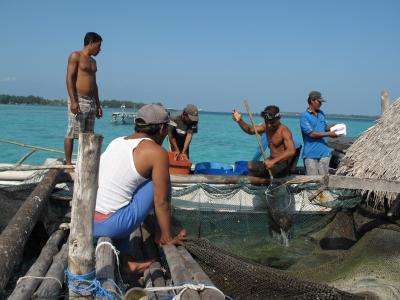Indonesian fishing communities find balance between biodiversity and development

Fishing communities living on the islands of Indonesia's Karimunjawa National Park have found an important balance, improving their social well-being while reducing their reliance on marine biodiversity, according to the Wildlife Conservation Society and the University of Western Australia.
Over the past 5 years, the Government of Indonesia has turned Karimunjawa National Park—a marine paradise of turquoise seas and mangrove-ringed islands in the Java Sea just south of Borneo—into a model of co-management for the country, largely by increasing community participation in park governance and providing economic incentives such as the development of ecotourism and business enterprises to reduce fishing pressures.
The study now appears in the online version of Marine Policy. The authors include: Stuart J. Campbell, Tasrif Kartawijaya, Irfan Yulianto, and Rian Prasetia of the Wildlife Conservation Society; and Julian Clifton of the University of Western Australia.
"Community involvement in the management of fisheries in Karimunjawa has had a significant impact on improving the sustainability of these resources," said Dr. Stuart Campbell, lead author on the paper. "One outcome has been the stabilization of reef fish biomass in some areas since the zoning regulations have taken effect. Another important outcome has been the improved socioeconomics and political power of participant communities, the key to any successful endeavor in sustainable development."
Karimunjawa National Park covers some 1,100 square kilometers of sea surrounding a total of 27 islands with a resident population of 9,000 people. The protected area was among the first in Indonesia to be recognized as critical for the conservation of the region's marine biodiversity. The coastal reef systems provide numerous fish species with spawning aggregation sites, important for the long-term conservation of commercially valuable species. The islands contained in the park provide valuable nesting sites for both sea turtles and seabirds.
In 2006, a study by WCS and others revealed that Karimunjawa's natural resources were under threat from overfishing, with the park's coral reefs and fish biomass in poorer condition than marine protected areas where community and traditional management systems were in place.
Since that time, the Karimunjawa National Park Authority has increased community participation in the management of Karimunjawa's natural resources. Villages now have institutions to address and resolve stakeholder conflicts. Incentives provided to communities have promoted awareness of and support for fishing regulations (which include closures to protect spawning fish sites) and gear restrictions designed and implemented by community members themselves.
The economic incentives of the new plan have decreased dependency on the park's natural resources, and the incorporation of user-rights by coastal communities into spatial planning helps eliminate unsustainable, destructive fishing. Most importantly, the communities and government officials work in tandem to enforce the rules of the park, prohibiting banned gear and catching and prosecuting fishers who illegally fish in the park.
"This co-management model is ideal for both marine conservation and local empowerment," said Dr. Caleb McClennen, Director of WCS's Marine Program. "The current plan's economic, legal, and participatory incentives have created a self-perpetuating system of exclusive access rights for local communities, who in turn support and enforce the protected area's policies and regulations."
Provided by Wildlife Conservation Society




















